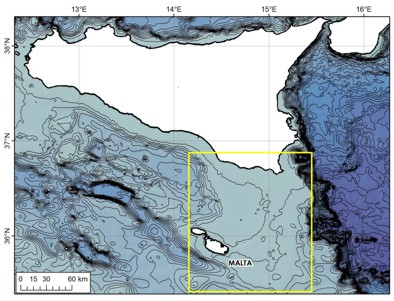Fluid flow systems of the Malta Plateau

The Malta Plateau is a shallow, asymmetric, north-south striking ridge located between Sicily and the Maltese Islands. New 2D seismic and side scan sonar data sets, sub-bottom profiles and seabed samples are investigated to characterise fluid flow systems on the Malta Plateau, determine their origin, and improve our general understanding of fluid flow focusing in terms of structural and stratigraphic controls. We demonstrate that fluid flow systems across the Malta Plateau are numerous, widespread and active. Two types of fluid flow systems are identified. The first type can be observed in the shallower parts of the western Malta Plateau. It consists of a shallow system where fluids ascend from gas-charged Plio-Pleistocene sediments and actively seep at the seafloor in the form of gas flares. The fluid migrating in this kind of system is likely autochthonous, biogenic gas (probably methane) forming at shallow depth. The second type comprises deep systems that can be observed in the central and eastern parts of the Malta Plateau. In these deep systems, fluids generated in Late Mesozoic sediments ascend through Late Cretaceous, Tertiary and Plio-Pleistocene units, and are expelled at the seafloor in the form of pockmarks. Late Mesozoic faults, Early Miocene to recent faults, and pipe structures constitute the preferred migration pathways. The migrating fluids are likely of thermogenic origin, possibly leaking from Mesozoic hydrocarbon reservoirs. Particularly in the north of Malta there is evidence that fluid migration is driven by overpressure at depth resulting from compressive events during the Late Cretaceous-Early Tertiary. Since the tectonic regime across the Malta Plateau is currently extensional, we propose that recent fluid migration and expulsion is at least partly driven by old overpressures and sustained by more recent normal faults. Our results show that the fluid migration must be taken into account when assessing seabed stability on the Malta Plateau. They indicate where chemosynthetic ecosystems may be located, and they improve our understanding of the petroleum geology of the Malta Plateau.
Micallef, A., Berndt, C. and Debono, G. (2011) Fluid flow systems of the Malta Plateau, Central Mediterranean Sea, Marine Geology, 284, 74-85.
Fluid flow processes in the Western Mediterranean
Veres, O., Lastras, G., Canals, M., Lafuerza, S., De Mol, B., Amblas, D., Durán, R., Costa, S., Micallef, A., Berndt, C. and HERMESIONE shipboard party (2011) Relief forming processes in the Eivissa channel, Western Mediterranean, Geophysical Research Abstracts, 13.








